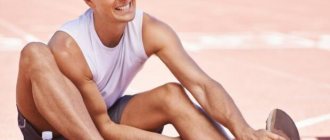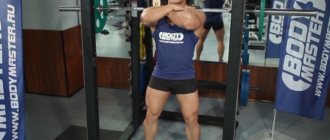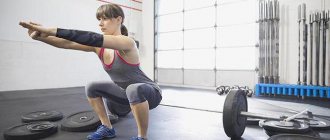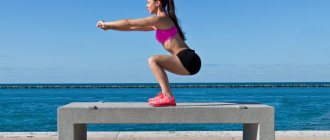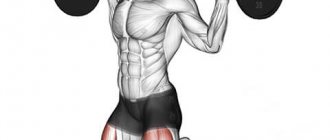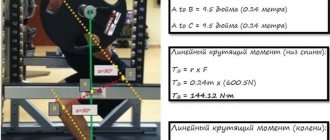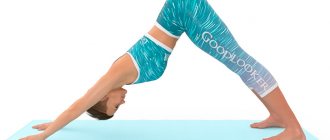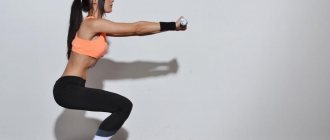What are squats
Squats are designed to strengthen muscles, which is why they are included in most workout programs. This very natural movement for a person, despite all its simplicity, perfectly maintains the muscles of the lower body in tone. To perform the exercise, no special equipment or special physical skills are required: raising and lowering the body is performed by bending the legs at the knees.
There are several types of squats, each of which has its own unique and beneficial properties and affects specific muscle groups. Based on your training goals, you can choose the most suitable option for yourself.
Contraindications to using squats as a method of losing weight
In order for a person to benefit from squats for weight loss and not cause harm to health, one must also take into account the fact that there are contraindications to performing exercises with a similar element. So, you cannot build a weight loss system on squats for people who have the following diseases:
- vertebral, umbilical hernia;
- curvature of posture (especially if it is scoliosis);
- hypertonic disease;
- ailments that are associated with the spinal column;
- disorders of the cardiovascular system;
- phlebeurysm;
- diseases of the lower extremities associated with poor functioning and functionality of the joints;
- radiculitis.
And if at least one of the above diagnoses is noted on your card, then, unfortunately, you will have to give up squats to lose weight in the abdomen, legs, thighs, and buttocks. By ignoring such recommendations, you expose yourself to great danger.
Benefits of squats
Performing squats is not difficult, but the properties of such an exercise clearly have great benefits for physical condition and health:
- Building muscle mass. Thanks to squats, the quadriceps and calf muscle fibers, hamstrings and others are actively worked out. Exercise tends to increase the production of testosterone and growth hormone in the body, thereby stimulating effective muscle building. The benefits of squats with a barbell or dumbbells for the arms are manifested in the activation of the biceps and triceps muscles.
- Fat burning. Actively working out muscles provokes the burning of fat in the body. By building muscle fibers, the body burns calories, thereby getting rid of fat cells. That is why squats have invaluable benefits for girls who want to lose extra pounds.
- Maintaining body mobility. In addition to strengthening the lower body, squats can also maintain mobility throughout the body as a whole. Interesting! Performing the exercise with full amplitude helps develop all the main muscles of the legs, which helps you not feel tired after prolonged physical activity.
- Improved coordination. To this property of squats you can also add the development of body mobility, which, in turn, helps improve strength skills and increase muscle mass. Squats provide the foundation for other calf development exercises: single-leg squats or calf raises.
- Development of physical capabilities. In addition to the benefits for individual areas of the body, squats can significantly improve the physical capabilities of the entire body: for example, after regular training, the distance you run or the length of your jump may noticeably increase. Squats also help improve performance in other sports, be it tennis or gymnastics.
- Preventing injuries. By developing a large number of accessory muscles in the lower region, the risk of injury or damage to muscle fibers is greatly reduced. The beneficial properties of squats contribute to the coordinated work of muscles and joints while maintaining a stable body position. It is only important to follow the correct technique for doing the exercises and follow the recommendations.
- Development of the sphincters of the central part of the body. Another benefit of squats is that they work the core of the body, including the abdominal area. Interesting to know! Research conducted in 2009 showed that the exercise can put more stress on the abdominal muscles than regular crunches. And squats on one leg tend to involve a large muscle mass, with the benefit of working the muscles of the legs and buttocks.
- Improvement of joint condition. Raising your body while performing a squat synchronizes the work of the hip joint, knees and ankles, evenly distributing the load and thereby reducing the risk of damage to them.
- Help the heart. Squats have invaluable benefits for the functioning of the heart. Unlike most strength exercises, squats do not load the heart muscle: on the contrary, they normalize its functioning. They can also serve as an excellent medicine for diseases such as ischemia or cardiac arrhythmia.
For women
- Working out the main muscles. Almost every girl and woman dreams of having a beautiful and toned figure, and squats are a great helper in this matter. The secret is that the properties of such an exercise will be useful in engaging a variety of muscle groups: in addition to the sphincters of the buttocks and legs, it also works the abs and back. Thus, one exercise can replace several at once.
- Ideal figure. Another useful property of squats for girls and women: regular exercises will help you quickly lose extra pounds, tighten your figure and form correct posture. Squats are also a good help in combating the female problem of cellulite.
- Improved blood flow. The functioning of blood vessels in the pelvic area is significantly improved. This is why the benefits of squats are so important for women after 40: they will help improve metabolism, tighten the skin in different parts of the body and significantly improve its appearance.
We recommend reading: The best vitamins for women over 40: reviews, names, which ones to choose
For men
- Increased blood flow. Active stimulation of blood circulation in the pelvic area improves microcirculation in all major tissues of this area. As a result, the skin becomes more elastic and toned.
- Working out the abdominal and back muscles, forming correct posture.
- Helps the functioning of the cardiovascular system. Squats with your own weight are of great benefit for men: their properties to strengthen the heart and blood vessels help turn exercise into a full-fledged cardio workout.
- Normalization of metabolism. By accelerating metabolism, the body burns fat cells much more actively and gets rid of the harm of accumulated toxins. Active fat burning, in turn, helps to build muscle mass.
Squats also have benefits for men's health, since they protect joints from damage during intense training in the gym.
Squats: what they are and how they are used
Squatting is a physical exercise, the essence of which is to lower the body while bending the knee joints. It is key not only in strength sports, but also for general physical fitness. There are many variations of this exercise, each better suited for a specific purpose. It can be performed with your own weight, with additional weights in your hands, with a barbell, etc.
This exercise is one of the basic ones in all strength sports, and is also indispensable in fitness and bodybuilding. When performing this exercise, all leg muscles are involved - gluteal, quadriceps and hamstrings, calves, and other small muscle groups.
The variability of the use of this exercise is very high - it can be used both to gain muscle mass and to burn fat; to increase endurance, to work out in detail each bundle of leg muscles, depending on the type of squat, to improve the overall tone of the muscles of the lower extremities, to strengthen the spine, to improve the condition of tendons and joints, and also to increase the strength of the legs. Squats can be performed with different foot positions , which affects the emphasis on one or another group of leg muscles. In addition, you can perform them on one leg, or with a jump, which allows you to very well increase the strength of the lower extremities.
Squats are used to tone and strengthen the lower extremities. They can make your legs stronger and more resilient. This exercise is included in the training process of any athlete, as it is the best for working the lower extremities.
Are squats good for children?
Despite the doubts of many parents, squats are a general strengthening exercise that cannot harm the child’s body. It is actively used in physical education classes in schools and sports clubs, be it swimming or basketball.
The properties of squats will be useful in the formation of an even posture, and in significantly strengthening the joint apparatus (especially the lower extremities, ligaments and tendons).
Moreover, the risk of harm to a child’s body from squats is much lower than for an adult. Squats will help in the formation of a strong skeletal apparatus, and will also be an excellent way to splash out accumulated childhood energy.
How to squat correctly
Before you apply all the beneficial properties of squats on yourself, you need to familiarize yourself with the rules for performing the exercises: to prevent possible harm and enhance the benefits of training:
- Movements should be performed smoothly and softly, without sudden jerks. You need to do the exercise thoughtfully and slowly, trying to feel every muscle in the body. If pain occurs, you should stop exercising and give your body time to rest.
- The optimal training option for beginners is 3 sets of 12 reps.
- Deep squats are especially useful for working the calf muscles. To perform them, you need to lower the body as low as possible.
- The knees should always be above the feet; there is no need to bring your legs together or spread them.
- The main weight of the body is transferred to the heels. The feet should be pressed firmly to the floor; you should not lift your feet off the surface or stand on your toes. This is the only way the gluteal muscle and hamstrings will receive maximum load.
- There is a classic diagram of the correct body position for performing squats: you need to stand straight with your feet shoulder-width apart. Move your pelvis back, imagining that there is an invisible chair behind you. A small box or stool will be an excellent helper for self-control. Do smooth squats while inhaling and exhaling deeply.
Types of squats and their benefits
In sports, there are several useful types of squats, each of which has its own unique properties. It is important to familiarize yourself with the features of each option in order to choose the most suitable one for yourself.
Classic squats
This type of exercise is aimed at uniformly working all the muscles of the legs. Regular squats are beneficial for training the quadriceps, hip adductors, glutes and soleus.
Standing straight, you need to place your feet hip-width apart and your arms along your body. After inhaling, move your pelvis back and bend your knees at a right angle. As you exhale, return to the starting position.
Plie
The benefits of plie squats help work the gluteal and quadriceps muscles of the thigh, as well as its inner surface.
The techniques for performing plie squats and classic squats are similar to each other, the only difference is in the starting position: in the plie, with your feet shoulder-width apart, you need to turn your toes outward at a right angle, and place your hands on your belt.
Sumo
Sumo squats are aimed at comprehensively working the muscles of the legs, buttocks and thighs. They develop hip flexibility and improve overall body mobility.
For the sumo position, you need to spread your legs wide apart, with your toes turned outward. Pull your hips back and squat until your knees form a right angle, then tighten your gluteal muscles as much as possible and return to a standing position.
Jump Squats
The benefit of jump squats is to increase the efficiency and intensity of your workout.
Place your feet shoulder-width apart, while inhaling, bend your knees, and as you exhale, jump sharply up. When your feet touch the floor surface, you must immediately perform the next squat.
Wall Squats
When performing wall squats, the quadriceps and gluteus maximus muscles are actively worked, and the exercise is most effective when adding weights. Wall squats also have benefits for the calves and soleus muscles.
Starting position for the exercise:
- Press your back, shoulder blades and buttocks tightly against the wall.
- Place your feet shoulder-width apart and bend your knees slightly.
- Bend your elbows and place them in front of you, one on top of the other.
Performance:
- After inhaling, without lifting your upper body from the wall, you need to sit down so that your shin and thigh form a right angle at the knee.
- Then you need to exhale, while straining your quadriceps, and return to the starting position.
Scissors
When performing the exercise, you can shift the main load to the anterior or posterior muscle groups. It all depends on the width of the legs: if you move your leg further, the main load will fall on the gluteal muscles and the back of the thigh. Bringing your legs closer together helps work your quadriceps.
You need to pick up the barbell and throw it over your shoulders. With your feet shoulder-width apart, you need to take a step forward. It is very important to control your back: it should be in a straight position, with a slight bend in the lower back.
After this, do a squat, bending both legs at the knees. It is also important to ensure that the knee of the leg in front does not extend beyond the foot. The knee of the second leg should touch the floor surface.
As you exhale, you need to take a vertical position.
Squats with a barbell or weights
Squats with a barbell provide benefits not only for beautiful and pumped buttocks. Such squats significantly improve health: their beneficial properties include strengthening joints and tendons, relieving back pain and normalizing heart function. They are able to speed up metabolism and rid the body of the harm of accumulated toxins.
Starting position: feet shoulder-width apart, holding a weight in your hands. Smoothly perform deep squats. It is important to ensure that your knees do not extend beyond your toes. As you exhale, return to the starting position.
The benefits of weightless squats are building endurance, burning excess fat, and strengthening the gluteal and thigh muscles.
Harm
If we talk about the adverse effects that are possible when doing squats, then this type of exercise in itself is safe. Problems can occur if you squat incorrectly. And this is due to this:
- During squats, there is an active load on the joints, muscles and tendons. If you complicate the exercise in the early stages with insufficient preparation, there is a high risk of injury.
- You should not do squats if your doctor advises you to temporarily stop exercising. Unauthorized performance of gymnastics in the presence of contraindications in most cases leads to a deterioration in health and damage to the limbs.
These are the main points associated with the negative aspects that can occur when performing squats. To prevent anything bad from happening, you should be attentive to your health and respond to signals about even the most minor failures.
Squats for weight loss
Squats are included in most workout programs for maintaining muscle tone and losing weight.
Classic squats are considered to be the most useful and effective in the fight against extra pounds: they actively strengthen the muscles of the body and promote effective fat burning. In the first week of classes, you need to do at least 3 workouts of 15-20 approaches with a break of 8-10 minutes. However, you should not be overzealous with the number of repetitions - excessive efforts can reduce the effectiveness of exercises and harm the body.
In order to calculate how many calories squats burn in the body, you need to multiply your weight by 0.1. The resulting number is the number of calories burned by squats in 1 minute. So, if a person weighs 70 kg, in 1 minute of exercise his body will burn 7 kcal, in 10 minutes - 70 kcal, respectively.
Interesting! Weighted squats significantly speed up calorie burning.
Beginners are recommended to start with 25 squats per set (on average, you need to do three sets per session), gradually increasing the load. During one such workout, the body can burn from 100 to 200 kcal: it all depends on the intensity of the exercises.
Squats for buttocks
Squats are the most useful and effective exercise for building a beautiful buttock shape. This is influenced by several factors: the shape of the pelvic bone, the volume of fat and the condition of the muscles.
If the size of the bones remains unchanged, then the beneficial properties of squats can manifest themselves in reducing body fat and working out muscles. However, you should not expect the first results after a week of training: they can be seen only after a month of active training. It is very important to combine squats with other exercise options for working the gluteal muscles: scissors, bicycle, lunges and planks. Squats also contribute to the formation of beautiful and slender legs and improve the overall health of women.
The greatest benefit for girls who want to build beautiful buttocks is deep squats (sumo): this is the main and indispensable exercise in building a beautiful figure. It is optimal to perform three approaches every 2 - 3 days, combining squats with other exercises.
How many squats to do
Beginners who are just starting to master the technique of squats should do no more than 30 times in 1 - 2 approaches. Start with 10 - 15 repetitions in one approach and increase the load over time. When squats begin to be performed easily and without difficulty, you can connect various weights with weights that allow you to do the same 10 - 15 times per approach.
There is a unique “method of a thousand squats”. Some may think that doing 1 thousand squats in a day is impossible. But this technique implies an even distribution of the load: you need to do only 10 repetitions in one approach throughout the day, increasing this number over time. Soon the body will be able to perform 100, 200, 500, and then 1 thousand squats per day without much difficulty.
Trainers recommend doing squats in the morning, when the muscles are most adapted to work: then the exercise will bring the greatest benefit.
Squats
18.06.2020 19:43
Author: Fitness trainer Sergey Konstantinov
Finding a simple, effective and universal exercise that will help improve the condition of the body and tidy up the figure is the dream of many supporters of a healthy lifestyle. In this case, you should pay attention to squats. This old and effective technique allows you to activate the functioning of body tissues, improve your mood and burn extra calories.
Harm of squats and contraindications
Despite all the beneficial properties, even such a simple exercise can cause serious harm to the body.
- The greatest danger is squats with weights: they put a serious load on the knee joints, which are not always able to withstand it. This often applies to people who prefer strength sports. In order not to cause harm to the tendons and joints of the knee area, it is necessary to warm up the muscles before training, which will significantly reduce the risk of injury.
- Squats are strictly contraindicated for people with knee joint diseases, since exercise can only increase inflammation and provoke immediate destruction of the joint.
- It is not allowed to squat if you have problems with the spine, scoliosis or diseases of the cardiovascular system. In this case, consultation with a doctor is required.
- Another possible harm factor is excess weight, which puts additional pressure on the knee joints. That is why overweight people need to do the exercise especially carefully and prudently. Start with a small number of repetitions to monitor the body's reaction. It is also recommended to use special bandages for knee joints.
Myth 1: You can't squat below parallel - it hurts your lower back.
Unfortunately, the benefits of squats have not always been and may be so clear. Some experts at a certain time period suggested that squats could have an extremely detrimental effect on the health of the knee joints. Many experts believe that squats can break down and in some way stretch our knee tendons, which can naturally weaken our knees and even cause pain.
To tell the truth, most experts still stipulated that such problems can be caused solely by improperly performed squats, especially with weights. At a certain point in time, squats as a physical activity were even completely removed from the main list of exercises intended for the American army.
DETAILS: Minimally invasive hip replacement
In any case, it should be understood that the benefits or harm from squats may be conditional if these exercises are performed incorrectly. It is extremely important to monitor your posture while performing such exercises. After all, an incorrect position when squatting your spine can ultimately cause harm, leading to injury.
It is absolutely forbidden to perform any squats under load (with a certain weight in your hands) without the constant supervision of an experienced trainer or a professional powerlifting instructor or bodybuilding instructor in general!
And of course, so that squats do not harm you, you need to clearly understand how to perform this or that squat and naturally perform the chosen exercise correctly.
The benefits of squats for girls are very great, but you need to keep in mind that even this useful exercise can be harmful. Knee joints receive a lot of stress in everyday life, when walking. And for athletes, knees are generally a big place. Very often, football players, athletes, sprinters - those who regularly deal with cardio loads - suffer from problems with them.
Bodybuilders also have similar problems. This is due to the fact that they use heavy weights. This can cause the knee tendons to stretch and the joints to become weaker. Professional athletes often use drugs such as chondroprotectors, which help minimize the dangerous consequences of using weights. Girls should not use heavy weights, because often they do not want to build up large muscle mass.
We know how squats are beneficial for girls. But keep in mind that in some cases they can cause harm. This mainly concerns ignoring contraindications and incorrect exercise technique. It is worth knowing the following points:
- Squats with weights often pose a particular danger. Your weight is a serious strain on your knees, but they can handle it. When squats, the tendons are stretched, putting stress on the joints. If done in moderation and without additional weights, they are unlikely to be harmful. However, there are girls who prefer strength sports. They should take this issue as responsibly as possible, use different joint supports and warm up before exercises.
- A person may suffer from diseases of the knee joints. If they hurt even when you run, then squats may be contraindicated, since they can aggravate the problem and provoke obvious destruction of the joint.
- Squats, whose benefits and harms for women are not so clear, are contraindicated for problems with the spine, scoliosis, and diseases of the cardiovascular system. In any case, it is better to consult a doctor.
- Overweight. Overweight people often justify themselves by having big bones. It must be said that nature certainly did not provide for wide joints, and excess weight is an additional load on them, and quite a high one at that. Therefore, you need to squat extremely carefully. It is recommended to start with a small number of repetitions and use special bandages that are used to wrap the knee joints.
For overweight people, squats need to be supplemented with cardio exercises, since burning excess fat is the first thing you should take care of.
The answer to the question of whether squats are beneficial for women may depend on the correct technique. And this again primarily concerns additional weights. When performing exercises, do not slouch or arch your back, otherwise the load on it will be too great.
Before squats, do a short warm-up. It will help stretch your joints and tendons, warm up, and prepare your muscles for the load. Actively performing exercises when the tissues are not warmed up can provoke sprains and ruptures of ligaments and joint injuries.
Caution is needed when performing squats on older people. Warm-up plays a huge role. It should be long so that the muscles, tendons and joints warm up properly.
Squats, the benefits of which for women significantly outweigh their harm, truly have a beneficial effect on both the figure and health. However, if you experience even minimal pain in your knees while doing exercises, consult a specialist immediately.
This misconception is explained by the fact that weights inhibit blood circulation as the muscles contract over a period of time. But such an increase in pressure is not dangerous - after training the body will return to normal. Regular weight training strengthens the respiratory system, heart, and blood vessels, so soon strength training will not cause discomfort.
If during squats your blood pressure goes through the roof and your health worsens, you should consult a specialist. You may have medical conditions that are a contraindication to performing squats.
Anna Dolgikh, personal trainer, certified specialist in physical fitness and rehabilitation. Multiple winner of rhythmic gymnastics competitions. Certified specialist in stretching, classical and step aerobics, strength and functional areas
During squats, the calf and gluteal muscles, back, hips, and quadriceps work. Taking on additional weight, such as a barbell, increases the load on your upper body. In this case, it is important to keep your back straight and maintain a certain body position.
Squats are a basic exercise around which myths are born. Most often you can hear that people “blame” squats for their knee pain and sciatica. Injuries and damage can only happen if you do not follow the execution technique or take very heavy weight.
DETAILS: Lower limb joint replacement
Before you include squats in your workouts, you need to learn what types there are and what their differences are. The right style is the key to success. Then the classes will be beneficial and enjoyable. Don't worry about the compression load - your back and knees can handle it if you follow all the rules.

